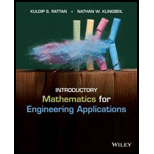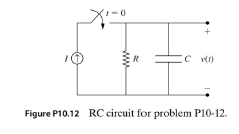
Concept explainers
The circuit shown in Fig. P10.12 consists of a resistor and capacitor in parallel that are subjected to a
(a) Find the transient solution,
(b) Find the steady-state solution
(c) Determine the total solution for
(d) Calculate the voltage at times

Want to see the full answer?
Check out a sample textbook solution
Chapter 10 Solutions
Introductory Mathematics for Engineering Applications
Additional Math Textbook Solutions
University Calculus: Early Transcendentals (4th Edition)
A First Course in Probability (10th Edition)
Elementary Statistics (13th Edition)
Probability And Statistical Inference (10th Edition)
Thinking Mathematically (6th Edition)
- -0-3-0-8 10 = = 5 Determine if w can be written as a linear combination of V1, V2, and v3. Show all of your work and justify your conclusions.arrow_forwardQ1.2 1 Point Which of the following best describes Span O a point two points a line O a plane O all of R³ Save Answer Q1.3 1 Point Which of the following best describes Span O a point two points a line O a plane O all of R³ Save Answer Q1.4 1 Point Which of the following best describes Span O a point O three points a line O a plane O all of R³ Save Answerarrow_forward3/5 as a percentagearrow_forward
- Please ensure that all parts of the question are answered thoroughly and clearly. Include a diagram to help explain answers. Make sure the explanation is easy to follow. Would appreciate work done written on paper. Thank you.arrow_forwardPlease ensure that all parts of the question are answered thoroughly and clearly. Include a diagram to help explain answers. Make sure the explanation is easy to follow. Would appreciate work done written on paper. Thank you.arrow_forwardPlease ensure that all parts of the question are answered thoroughly and clearly. Include a diagram to help explain answers. Make sure the explanation is easy to follow. Would appreciate work done written on paper. Thank you.arrow_forward
- Please ensure that all parts of the question are answered thoroughly and clearly. Include a diagram to help explain answers. Make sure the explanation is easy to follow. Would appreciate work done written on paper. Thank you.arrow_forwardRafael needs to make a total of 50 deliveries this week. So far he has completed 28 of them. What percentage of his total deliveries has Rafael completed?arrow_forwardPlease ensure that all parts of the question are answered thoroughly and clearly. Include a diagram to help explain answers. Make sure the explanation is easy to follow. Would appreciate work done written on paper. Thank you.arrow_forward
 Linear Algebra: A Modern IntroductionAlgebraISBN:9781285463247Author:David PoolePublisher:Cengage Learning
Linear Algebra: A Modern IntroductionAlgebraISBN:9781285463247Author:David PoolePublisher:Cengage Learning
